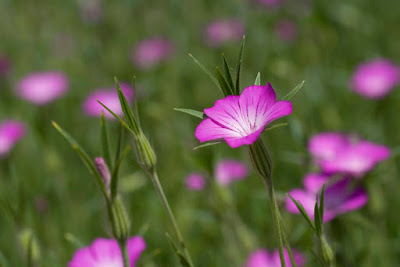Dear Haijin, visitors and travelers,
Welcome at the last (regular) episode of this month in which we were creating a "bouquet of wildflowers" under the title "field of flowers". I have chosen another nice wildflower ... Corncockle or Agrostemma githago. A beautiful field flower with a wonderful color, magenta.
 |
| Corncockle |
Let me tell you a little bit more about this beautiful field flower:
'Cuckole hath a longe small lefe, and wyl beare fyve or vi floures of purple colour, as brode as a grote' - Fitzherbert "The Boke of husbandrie" (1523)
A slender pink flower of European wheat fields, the Corncockle was regarded as very common in the 19th century.
Its seeds were harvested and re-sown for the following season, until it began to decrease rapidly, beginning most noticeably in 1952. The plant was seen as a pest by farmers for hundreds of years but is now rarely seen due to the improved seed cleaning techniques and herbicides of modern farming putting it at risk. These days it is only seen occasionally for instance when old pastureland is ploughed, or when it has been sown deliberately in wildflower gardens such as Earlham churchyard in Norwich.
Corncockle is 1 metre tall and covered with fine hairs. It has few branches and they are each tipped with a single deep pink to purple scentless flowers. They are 25 mm to 50 mm across and each petal bears 2 or 3 discontinuous black lines. The leaves are pale green and are 45 mm to 145 mm long. It has been described by Richard Mabey as 'one of the most attractive of cornfield annuals'.
 |
| Corncockle |
By the way the Corncockle is a poisonous flower, so be aware, it also is an endangerous species, so maybe your haiku, tanka or other Japanese poetry form can be a tribute to the beauty of the Corncockle.
This episode is NOW OPEN for your submissions and will remain open until September 5th at noon (CEST). I will try to publish our new weekend meditation, the first of autumn, because September 1st is the meteorological start of autumn.

No comments:
Post a Comment